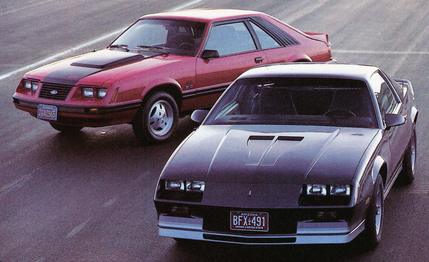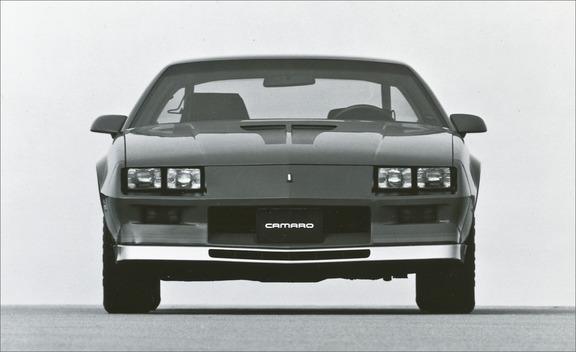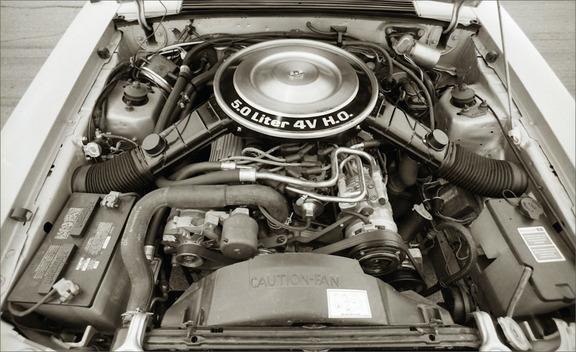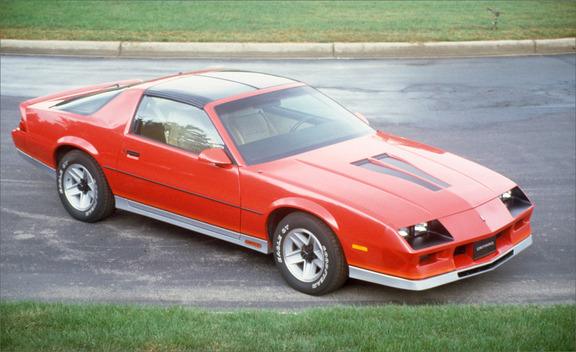 Archived Comparison
Archived Comparison

Pony-car fans have more to be excited about today than they’ve had in 40 years—not only are both the Mustang GT and Camaro SS above the 400-hp threshold, but there’s even a horsepower war raging between the V-6 editions. Next week, we’ll post comparison tests between both the current eights and the sixes, but for now, enjoy this series of past encounters between two of Detroit’s most storied cars.
The shackles of emissions regulations began to come off in the ’80s—or rather, car companies began to understand how to work within the constraints of the rules. By the time the Mustang and Camaro met up for a head-to-head in June of 1983, their V-8s (302 and 305 cubic inches, respectively) had, uh, improved to175 and 190 hp. Thank goodness (well, and massively improved computer controls and engine technologies) for today’s 400-plus-hp pony cars.
______________________________________
These are serious cars. It used to be you could make fun of American cars with big V-8s like this, but these days you think twice before uncorking the brew beneath the hood. What's more, these cars go around corners. Machines like this aren't for sissies anymore.
Both Ford and Chevrolet know it, too. They understand that the deal here is performance—performance unfettered by concessions to "reasonable transportation." In fact, the Camaro Z28 and the Mustang GT have become the focus of the first all-out performance contest between Ford and Chevrolet since the Sixties. That war for domination of the all-American-GT class prompted our "Red Speed" shootout last August. And its continuing importance to the folks in Warren and Dearborn—not to mention to those of us who relish driving at speed—has led to this return bout.
Since another year of development has gone into these GTs, we've made the rematch a little tougher. In this test, Mustang and Camaro go against the watch at the test track, on a racetrack, and over an open-road course.
The engineers at Ford and Chevrolet take this match-up of title contenders just as seriously as we do. Last year the Chevy guys were grinding their teeth in frustration: their 165-hp 5.0-liter V-8 with throttle-body fuel injection wasn't enough to keep the overweight Z28 from getting sand kicked in its face by the lean Mustang GT at the stoplights. As a "development project," they built a hot engine for the 24 Hours of Nelson Ledges road race. Soon, their enthusiasm spilled over into the whole engineering team, and the result is a 190-hp production version of that engine, designated H.O. for "high output."

The H.O. engine starts life as Chevy's conventional 5.0-liter V-8 with its TBI intake system removed. Intake and exhaust tuning is the source of extra under-hood vitality this year. The L83 camshaft from the '84 Corvette increases valve lift and duration, and also moves the power peak 600 rpm higher and the torque peak 800 rpm higher. An all-new exhaust system, with two-and-a-quarter-inch header pipes, a high-flow Corvette catalyst, and a single two-and-three-quarters-inch pipe to the dual-outlet muffler, minimizes back pressure. A Rochester four-barrel carburetor with electronic feedback control increases intake flow by 71 percent over that of the vaunted TBI unit, while a dual-snorkel air intake (which picks up cool air from behind the headlights) boosts output by another 12 hp.
The end result is 190 hp at 4800 rpm, and the knock sensor in the electronic ignition can adjust the timing to deliver another 10 hp if you fill up with premium unleaded. All this power goes through a Borg-Warner T-5 five-speed. Aside from strengthening the torque arm to control rear-axle windup in the face of this additional power, the chassis remains virtually the same.
Unfortunately for the Chevy guys, their counterparts at Ford haven't been resting on their laurels. They also have Borg-Warner's five-speed for '83. And after coaxing 157 hp out of their 5.0-liter V-8 last year with much the same strategy Chevy discovered for this year, the Ford engine boffins have boosted output yet again, to 175 hp at 4200 rpm, complete with five more pounds-feet of torque and a slightly broader power band. A Holley four-barrel doubles the flow of last year's two-barrel, while a straighter catalyst connection minimizes back pressure. Finally, a seventeen-inch-diameter air cleaner replaces the former fifteen-incher. As before, there's hardly a trace of electrickery under the hood. The Ford guys say that electronic controls are too often used as Band-Aids to patch the gaps in the knowledge of engineers. Besides, they say, enthusiasts like to work on their engines, and electronics discourage them.
The pressure of constantly increasing horsepower forced the Mustang chassis engineers to revise their car's suspension once again, even though it underwent a comprehensive rethink last year. Fifty-percent-stiffer rebound damping for the shocks gives the car a more aggressive grip on the road. A larger rear anti-sway bar dials away some of the understeer. Most important, the Michelin TRX tires have been upgraded from 190s to 220s, while their construction and compound have been changed to improve wet and dry traction as well as handling. A twenty-percent-faster steering-gear ratio and minor alignment changes also help the Mustang respond better to changes in direction. In addition, there are numerous modifications to improve ride quality.

Of course, what really matters about the new Camaro and Mustang is what they do. The standard of measure is simple: a car either gets it, or it doesn't. You can feel the difference in your gut, so there's no need to establish a complicated set of ground rules. You just toss the competitors into the ring and see how they perform.
The quarter-mile round at Orange County International Raceway went to the lean Mustang last year because of its superior power-to-weight ratio, but this year the Z28 has a fractional edge in that department. It took a little feathering of the clutch and a modest 1800 rpm to launch the Mustang without smoking its tires uselessly, but then it just rocked back on its new, softer rear springs and accelerated away, its five-speed shifting flawlessly. The Camaro required a dramatic getaway at full revs with lots of wheelspin to do its best, sprinting away with a slight tramp of the rear axle, its five-speed shifting far more easily than the old four-speed, though not quite as cleanly as the Mustang's.
Both these cars are quick. The Mustang is just as fast as the '84 Corvette with automatic transmission, according to our prototype tests. And the H.O. Z28 is faster still, beating the Ford to 60 mph by three-tenths of a second, and then grabbing another tenth by the end of the quarter-mile. The Camaro's slightly better power-to-weight ratio, better weight distribution, and better tires make the difference.
The slalom contest wasn't nearly as close, however: the Z28 simply dominated the event, averaging a speed of 60.6 mph versus the Mustang's 57.9 mph. The Camaro carves its way from gate to gate; it changes direction completely and without hesitation, just like a race car. You just steer; the car does the rest. In contrast, the Mustang slithers through the gates, heeling over onto its outside front tire and understeering from one cone to the next.
Both cars suffer from a lack of steering feel. It's impossible to keep track of the Mustang's back end, which tried to assist with the maneuvering in our slalom. The Camaro steers so lightly that you can't drive with the precision the chassis prefers.
The session at Willow Springs Raceway meant more than just a joy ride. First of all, a racetrack is the safest place to find the limits of an automobile's handling. Second, a lot of Mustangs and Camaros will find their way to the racetrack this year in the SCCA's new Showroom Stock GT class, where they'll compete against the likes of the Datsun 280-ZX Turbo, the Mercury Capri RS, the Pontiac Firebird Trans Am, and the Porsche 944.
At Willow, it was immediately apparent that each car offers a different strategy for speed. The Mustang is easy to drive at a moderate pace: its broad power band, firm brake pedal, and predictable understeer inspire confidence. It understeers mightily through fast corners, but a quick lift of the throttle brings the tail out for slow turns. The Camaro, on the other hand, steers around turns at all speeds with very little roll or drift angle to suggest the speed at which you're traveling; you just hang the front tires on the line and stand on the gas.
As speeds increase, the Mustang gets worse and the Camaro gets better. The Ford skates into turns, reminding you of its limited 0.76-g capability on the skidpad. The inability to heel-and-toe makes approaches to slow corners exciting, while the lifeless steering makes it impossible to check the sliding rear tires with any predictability. In slow- and medium-speed right-handers, the Mustang's dreaded rear-axle hop raises its ugly head, and in left-handers the rear tires try to beat you to the exit. In comparison, the Camaro feels the same as before, only faster. It plunges into a corner far harder than the Mustang, front and rear tires working in close-coupled harmony, its 0.83-g capability conserving the momentum gathered on the straight. The Z28 is the closest thing to a race car built on an American assembly line, closer even than the Corvette. Still, the steering continues to be an obstacle, making you a little overconfident. In the end, the Z28 dominated the Willow Springs round, with a margin of 3.3 mph over the Mustang.

Our final round of testing—real world performance driving on a favorite stretch of the Ortega Highway—promised to favor the Camaro again. Indeed, the Z28 felt tremendous. The narrow slit of its windshield, the proximity of seat to floor, and the lack of roll in the corners seemed synonymous with speed. The Mustang felt like a Mafia triggerman, moving through corners in deliberate, large-amplitude motions, the driver sloshing around in his upright posture like the only olive in a large jar. Surprisingly, however, there was no significant difference between the cars in our timed runs. But the Camaro felt significantly better.
The explanation might be found in the broad power band of the Mustang's engine. In a contest of roll-on acceleration from 65 mph in fifth gear, the Mustang quickly jumps out to a half-length lead, which it holds to 90 mph. But the Ortega shoot-out reveals how ephemeral that last bit of extra performance can be. We can measure that performance in many different ways, yet we can't know if it truly makes a difference in everyday driving.
In sum, the Mustang builds up to its limits very quickly, and in a fashion the citizen driver can use to excellent advantage. The Z28's limits are much higher, but they're also harder for the ordinary driver to attain.
Still, in our judgment, there's no doubt that the Chevrolet Camaro Z28 H.O. is the better of these two well-muscled GTs. It's not just a question of limits. At speed, you can feel the difference: the Camaro is stable and calm (aside from the front windows' pulling away from the body) at its top end of 134 mph, while the Mustang feels nervous and on tiptoe at its 128-mph peak.
There's another reason the Z28 flat gets it, and the explanation lies elsewhere than in our mass of performance data. The deal is, the Camaro's extraordinary steering response and amazing grip in the corners provide an extra margin of maneuvering ability no matter what speed you drive; they encourage you to take full advantage of the car's capabilities. The Z28 is the right car for negotiating hundreds of miles of two-lane roads, for driving conditions that test your skill and not just your bravery. The Camaro gets you to your destination quickly, safely, and in a relaxed frame of mind.
When you come right down to it, the Mustang and Camaro are awfully close. If you like low-speed stunt driving accompanied by clouds of tire smoke, the Mustang GT gets it. But when it comes to real driving, to harnessing the power of a big American V-8 and putting it down on the road, the Camaro Z28 H.O. is the clear winner.
Development has improved both cars tremendously. This year, Chevrolet wins by a nose, but who can guess what Ford is tooling up for 1984?
